30 Days of Blogging is going to have to take a brief pause. I'm in the mountains for a few days, and the wireless here is terrible.
It's almost like I'm supposed to commune with nature or something.
Friday, April 25, 2014
Thursday, April 24, 2014
Open All the Doors and Let You Out Into the World
It's the happiest, saddest time of the year.
It's graduation season.
The past few weeks, as they always are at this time of year, have been a daily cycle of wrap up meetings, transition meetings, banquet dinners, farewell lunches, award ceremonies, hugs, photos, and any number of other events leading to one thing: graduation.
Lights out.
Closing time.
It's the time of year when we say goodbye.
I work with students, and I love working with students.
I work with amazing student leaders, who have a mission and a vision and a cause, and effortlessly talk others into following them.
I work with students who are going to change the world someday, and students who are already changing it now.
I work with students who are passionate about making our campus a better place, or our city, or our state, or our country, or our world.
I work with students who are amazingly talented, students who are poets and dancers and actors and singers and musicians, artists and builders and makers and world shapers.
I work with students who work for change, and with students who work to preserve and honor tradition.
I work with students who are raising children that I would sit next to in a restaurant.
I work with students who are geniuses, students whose minds move at faster paces and higher levels than I can easily imagine.
I work with students who fight prejudice and inequity, students who strive to live and breathe social justice and positive empowerment, students who want to bring us together and raise us all up higher.
I work with students who will become teachers, doctors, dentists, lawyers, politicians, accountants, chefs, mothers, fathers, writers, photographers, reporters, physicists, soldiers, ambassadors, and any other job you can think of.
I work with students who teach me new things every day, and I hope that somewhere, in some way, I've taught them something, too, and that it was something worth knowing.
I work with students, and then I wave from the doorway of my office as we turn them out into the world.
Then I clean up my desk, straighten my office, and wait for next year.
When I will work with students again.
It's graduation season.
The past few weeks, as they always are at this time of year, have been a daily cycle of wrap up meetings, transition meetings, banquet dinners, farewell lunches, award ceremonies, hugs, photos, and any number of other events leading to one thing: graduation.
Lights out.
Closing time.
It's the time of year when we say goodbye.
I work with students, and I love working with students.
I work with amazing student leaders, who have a mission and a vision and a cause, and effortlessly talk others into following them.
I work with students who are going to change the world someday, and students who are already changing it now.
I work with students who are passionate about making our campus a better place, or our city, or our state, or our country, or our world.
I work with students who are amazingly talented, students who are poets and dancers and actors and singers and musicians, artists and builders and makers and world shapers.
I work with students who work for change, and with students who work to preserve and honor tradition.
I work with students who are raising children that I would sit next to in a restaurant.
I work with students who are geniuses, students whose minds move at faster paces and higher levels than I can easily imagine.
I work with students who fight prejudice and inequity, students who strive to live and breathe social justice and positive empowerment, students who want to bring us together and raise us all up higher.
I work with students who will become teachers, doctors, dentists, lawyers, politicians, accountants, chefs, mothers, fathers, writers, photographers, reporters, physicists, soldiers, ambassadors, and any other job you can think of.
I work with students who teach me new things every day, and I hope that somewhere, in some way, I've taught them something, too, and that it was something worth knowing.
I work with students, and then I wave from the doorway of my office as we turn them out into the world.
Then I clean up my desk, straighten my office, and wait for next year.
When I will work with students again.
Wednesday, April 23, 2014
How to Read at Lunch
People who know me know that I read a few books a year, and a lot of that happens at lunchtime. Twice in the past week (and once for a minute on Twitter) I was discussing reading with someone, and mentioned that I read at lunch, and both times in person the people I was talking to were shocked, as if reading at lunch was some kind of achievement.
"How do you manage to do that?"
My initial thought was, "I open the book. Then I look at the page," but then I started thinking that maybe this really was something that people had trouble figuring out. Since I manage to get in a good hour of reading time three to five lunches a week, I thought about it on my way home tonight and broke down some basic rules of reading at lunch. These are the things that I do when I don't have a lunch meeting or a lunch invitation:
1) Leave your workspace. If you stay at your desk, you are still working. If you shut your door, people are going to knock on it. If you leave your door open, people are going to think you're a slacker who sits around your desk reading instead of doing work. Even if people don't knock, the phone will ring. You can let the calls go to voicemail, but then you know that you're going to have to listen to them after lunch, and you'll be tempted to listen to them now to get them out of the way. Again, there's a simple solution: leave your workplace during lunchtime. Take your book and lunch with you, or take your book to the place where you buy lunch.
2) Own your lunch time. If you get an hour for lunch, take the entire hour. If you have a half hour, take the whole half hour. If the first assistant gets twenty minutes and you get fifteen when she returns, because someone must man the desk and answer the phones at all times, then take your fifteen minutes. It is your time. You have earned it. It belongs to you. Yes, you have a lot of work to do. You'll still have a lot of work to do after lunch. Let it sit for an hour. If you're in the middle of an emergency or your director suddenly needs a report before a meeting in an hour, stay and handle what needs to be handled, but then take a lunch, and take the whole thing.
3) Leave your phone. Unless you're reading a book on your phone, you don't need your phone. What's the point of leaving work to go read if you bring work with you? If you're going to do that, you might as well just stay at your desk.
4) Be prepared to say no to people. I eat lunch at the dining facility closest to my office most days of the week. I know ninety percent of the people who eat lunch there, so at least once or twice a week someone will ask who I'm eating with, and then ask if I want to sit with them. Most days, I politely decline. "No, thanks, I'm going to read," sounds a little better than, "No, thanks, I have a book," but use whatever fits your style.
5) Be prepared to sometimes say yes to people. Every once in a while, when people ask if I want to sit with them, I say yes. If you say no every time, eventually people will stop asking you. If that's your goal, by all means ignore this rule, but if you still want to have friends and friendly coworkers, it's ok to randomly say yes. Just be sure to mention that you were planning to read, so that next time they see you with a book they won't be offended if you say no to their invitation.
6) One hand for food, one hand for reading material. These should not be the same hand, unless you like your books smeared with lunch.
If you're planning to read at lunch, I hope this helps.
"How do you manage to do that?"
My initial thought was, "I open the book. Then I look at the page," but then I started thinking that maybe this really was something that people had trouble figuring out. Since I manage to get in a good hour of reading time three to five lunches a week, I thought about it on my way home tonight and broke down some basic rules of reading at lunch. These are the things that I do when I don't have a lunch meeting or a lunch invitation:
1) Leave your workspace. If you stay at your desk, you are still working. If you shut your door, people are going to knock on it. If you leave your door open, people are going to think you're a slacker who sits around your desk reading instead of doing work. Even if people don't knock, the phone will ring. You can let the calls go to voicemail, but then you know that you're going to have to listen to them after lunch, and you'll be tempted to listen to them now to get them out of the way. Again, there's a simple solution: leave your workplace during lunchtime. Take your book and lunch with you, or take your book to the place where you buy lunch.
2) Own your lunch time. If you get an hour for lunch, take the entire hour. If you have a half hour, take the whole half hour. If the first assistant gets twenty minutes and you get fifteen when she returns, because someone must man the desk and answer the phones at all times, then take your fifteen minutes. It is your time. You have earned it. It belongs to you. Yes, you have a lot of work to do. You'll still have a lot of work to do after lunch. Let it sit for an hour. If you're in the middle of an emergency or your director suddenly needs a report before a meeting in an hour, stay and handle what needs to be handled, but then take a lunch, and take the whole thing.
3) Leave your phone. Unless you're reading a book on your phone, you don't need your phone. What's the point of leaving work to go read if you bring work with you? If you're going to do that, you might as well just stay at your desk.
4) Be prepared to say no to people. I eat lunch at the dining facility closest to my office most days of the week. I know ninety percent of the people who eat lunch there, so at least once or twice a week someone will ask who I'm eating with, and then ask if I want to sit with them. Most days, I politely decline. "No, thanks, I'm going to read," sounds a little better than, "No, thanks, I have a book," but use whatever fits your style.
5) Be prepared to sometimes say yes to people. Every once in a while, when people ask if I want to sit with them, I say yes. If you say no every time, eventually people will stop asking you. If that's your goal, by all means ignore this rule, but if you still want to have friends and friendly coworkers, it's ok to randomly say yes. Just be sure to mention that you were planning to read, so that next time they see you with a book they won't be offended if you say no to their invitation.
6) One hand for food, one hand for reading material. These should not be the same hand, unless you like your books smeared with lunch.
If you're planning to read at lunch, I hope this helps.
Tuesday, April 22, 2014
Dreamscapes
I noticed this morning that my subconscious mind is having a hell of a time with 30 Days of Blogging. Add in "Throwback Thursday" on Facebook, when I have to go through my photo albums and find pictures of myself (an actual challenge since my low self esteem usually keeps me from getting in front of a camera), and we're dredging a lot of stuff out of the memory hole.
My brain has chosen to respond to this with some really vivid dreams about people, places, pets, and things that I haven't seen or spoken to or visited in years. This has been a strange experience.
Two nights ago, I had a dream where Vern (who we also called Moose), a dog that we had for (I think) fourteen years who died before I went to college warned me about talking to ghosts in the hallway. He barked until I left the ghost alone.
At least four times this month I've dreamed about Scruffy, the best dog in the world.
I see faces that don't have names.
I've seen the same faces while flipping through my photo albums. These people must have been important to me once, or they were at least people that I knew, because I took pictures of them. I look at them now and grasp for names. Heather? Is that a Heather? I knew a lot of girls named Heather. Still do. Maybe it was a Courtney?
The other night, I visited our home in Alaska. I can't remember the apartment number, but our zip code was 98733. When we moved away in 1988, the boy who lived next door was named Charley. Or Charlie? He was in my dream. Also, I had rollerskates.
I'm not sure what I'm trying to say here.
I just know that I've been waking up, every night, at two or three in the morning. It takes me a half hour to an hour to fall back to sleep. When I'm awake, I look at pictures, and try to remember who those people were. Or are.
I wonder how many of them remember me.
My brain has chosen to respond to this with some really vivid dreams about people, places, pets, and things that I haven't seen or spoken to or visited in years. This has been a strange experience.
Two nights ago, I had a dream where Vern (who we also called Moose), a dog that we had for (I think) fourteen years who died before I went to college warned me about talking to ghosts in the hallway. He barked until I left the ghost alone.
At least four times this month I've dreamed about Scruffy, the best dog in the world.
I see faces that don't have names.
I've seen the same faces while flipping through my photo albums. These people must have been important to me once, or they were at least people that I knew, because I took pictures of them. I look at them now and grasp for names. Heather? Is that a Heather? I knew a lot of girls named Heather. Still do. Maybe it was a Courtney?
The other night, I visited our home in Alaska. I can't remember the apartment number, but our zip code was 98733. When we moved away in 1988, the boy who lived next door was named Charley. Or Charlie? He was in my dream. Also, I had rollerskates.
I'm not sure what I'm trying to say here.
I just know that I've been waking up, every night, at two or three in the morning. It takes me a half hour to an hour to fall back to sleep. When I'm awake, I look at pictures, and try to remember who those people were. Or are.
I wonder how many of them remember me.
Monday, April 21, 2014
Too Funky
Tonight, on Day 21 of 30 Days of Blogging, I've decided to use a topic suggested by my friend Beth, who is a musician:
Talk about a time that music changed your life.
OK, but you're going to have to imagine yourself back to a time and place that few of you remember and some of you may not have been born yet in. Picture it, everyone:
Summer, 1992
It's a leap year. Bill Clinton is running for president, and so is Ross Perot. Euro Disney has just opened. Manuel Noriega is going to prison. "A League of Their Own" is the charming feelgood movie of the year, and stars my friend Lesley's little sister as an extra. This will be very exciting when I meet my friend Lesley in the fall of 1993.
I live on Fort Drum, an army base in upstate New York, on Blout Loop. Our street was supposed to be named Blount Loop, after William Blount, a signer of the US Constitution. Many of the streets in the housing areas on post were named after signers of the Constitution and the Declaration of Independence, but ours was spelled incorrectly. My father tried to have it changed, but the Army, being the Army, decided that if it said "Blout" on the sign then it was going to be Blout Loop because, hey, they already made the sign.
In a random coincidence, I now live in the same town as William Blount's historic mansion.
I've never been there.
This may be hard to believe, but I am socially inept. I don't speak to a lot of people, and I don't have a lot of friends. I'm about to enter the eleventh grade and I want high school to be over. Tenth grade was the worst school year of my life, but by the end of eleventh grade I will be friends with pretty much everyone that I choose to be. I just don't know it at the time. I don't know where I want to go, but I know where I don't want to stay. Also, I have a problem:
I don't move my arms when I walk.
I became aware of this when I overheard my parents' other child explaining to my mother how embarrassing it was to be related to me, and how the two of us pretended to be cousins at school. "Overheard" kind of implies that there was some effort made to hear this, but in actuality I was in the next room, loading the dishwasher. I didn't catch the entire conversation, but the gist of it was that I was a nerd, everyone hated me, I wasn't good at sports, and I was a freak who loped through the halls like Frankenstein's monster.
Wait, what?
"He doesn't move his arms when he walks. Like, people swing their arms, you know? He doesn't move his arms. He's a freak."
My parents' other child said a number of horrible things to and about me over the years, which we will maybe discuss more in a future entry, but for some reason this one seemed especially damning. Over the next few days, I found myself evaluating my walking, completely self conscious of my arms and my hands and what they were doing and whether it was the same thing that everyone else's arms and hands were doing when they walked and then I discovered that, oh God, it was true. I was a freak who somehow managed to walk without swinging my arms.
Fortunately, at this time I owned Scruffy, the best dog in the world, who slept on my bed every night and never told me I was a freak. I also owned a yellow Walkman with black headphones, and a cassette tape of "Red Hot + Dance", which included George Michael's "Too Funky". Together, somehow, these things added up in my mind to a solution for my non-swinging arms.
Here, watch the video while I attempt to explain:
What are the beautiful, glamorous people in the video doing?
Walking.
And swinging their arms.
And, God, is that not a fantastic song to walk to?
So, every night after dinner, since I had no friends' houses to go to, no parties to attend, and no shows to watch for a couple of hours, I strapped on my Walkman, popped my cassette in, and took Scruffy for a walk around Blout Loop. One trip around the loop was about as long as one playing of "Too Funky" and a few moments to rewind it, so I walked, and while one arm held the leash the other arm swung, deliberate, practiced swinging. I strutted and stomped in time to the music, and each time I got to my house I turned around, switched hands with the leash, and walked the other way.
By the end of summer, I was swinging my arms while I walked, just like a normal person.
And I have George Michael to thank for it.
Talk about a time that music changed your life.
OK, but you're going to have to imagine yourself back to a time and place that few of you remember and some of you may not have been born yet in. Picture it, everyone:
Summer, 1992
It's a leap year. Bill Clinton is running for president, and so is Ross Perot. Euro Disney has just opened. Manuel Noriega is going to prison. "A League of Their Own" is the charming feelgood movie of the year, and stars my friend Lesley's little sister as an extra. This will be very exciting when I meet my friend Lesley in the fall of 1993.
I live on Fort Drum, an army base in upstate New York, on Blout Loop. Our street was supposed to be named Blount Loop, after William Blount, a signer of the US Constitution. Many of the streets in the housing areas on post were named after signers of the Constitution and the Declaration of Independence, but ours was spelled incorrectly. My father tried to have it changed, but the Army, being the Army, decided that if it said "Blout" on the sign then it was going to be Blout Loop because, hey, they already made the sign.
In a random coincidence, I now live in the same town as William Blount's historic mansion.
I've never been there.
This may be hard to believe, but I am socially inept. I don't speak to a lot of people, and I don't have a lot of friends. I'm about to enter the eleventh grade and I want high school to be over. Tenth grade was the worst school year of my life, but by the end of eleventh grade I will be friends with pretty much everyone that I choose to be. I just don't know it at the time. I don't know where I want to go, but I know where I don't want to stay. Also, I have a problem:
I don't move my arms when I walk.
I became aware of this when I overheard my parents' other child explaining to my mother how embarrassing it was to be related to me, and how the two of us pretended to be cousins at school. "Overheard" kind of implies that there was some effort made to hear this, but in actuality I was in the next room, loading the dishwasher. I didn't catch the entire conversation, but the gist of it was that I was a nerd, everyone hated me, I wasn't good at sports, and I was a freak who loped through the halls like Frankenstein's monster.
Wait, what?
"He doesn't move his arms when he walks. Like, people swing their arms, you know? He doesn't move his arms. He's a freak."
My parents' other child said a number of horrible things to and about me over the years, which we will maybe discuss more in a future entry, but for some reason this one seemed especially damning. Over the next few days, I found myself evaluating my walking, completely self conscious of my arms and my hands and what they were doing and whether it was the same thing that everyone else's arms and hands were doing when they walked and then I discovered that, oh God, it was true. I was a freak who somehow managed to walk without swinging my arms.
Fortunately, at this time I owned Scruffy, the best dog in the world, who slept on my bed every night and never told me I was a freak. I also owned a yellow Walkman with black headphones, and a cassette tape of "Red Hot + Dance", which included George Michael's "Too Funky". Together, somehow, these things added up in my mind to a solution for my non-swinging arms.
Here, watch the video while I attempt to explain:
What are the beautiful, glamorous people in the video doing?
Walking.
And swinging their arms.
And, God, is that not a fantastic song to walk to?
So, every night after dinner, since I had no friends' houses to go to, no parties to attend, and no shows to watch for a couple of hours, I strapped on my Walkman, popped my cassette in, and took Scruffy for a walk around Blout Loop. One trip around the loop was about as long as one playing of "Too Funky" and a few moments to rewind it, so I walked, and while one arm held the leash the other arm swung, deliberate, practiced swinging. I strutted and stomped in time to the music, and each time I got to my house I turned around, switched hands with the leash, and walked the other way.
By the end of summer, I was swinging my arms while I walked, just like a normal person.
And I have George Michael to thank for it.
Sunday, April 20, 2014
Easter Evening Lois Lanesanity: Lois Takes the Stand
If you missed this morning's blog entry, you should go back and reread it, because this is a special two-part blog commemorating the two-part story of "Superman's Girlfriend Lois Lane" #99 and 100. If you've already read it, let's get back to our story in progress!
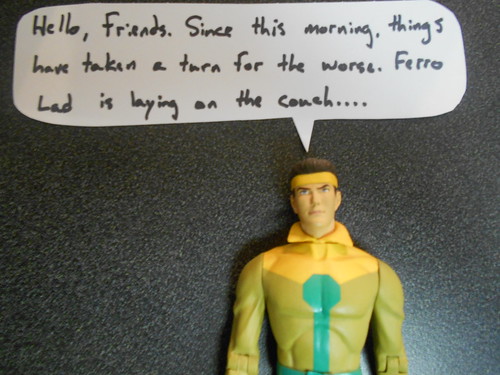
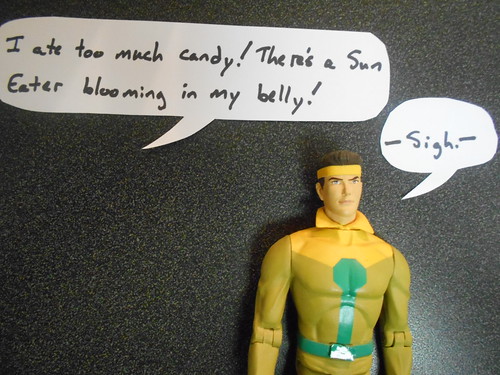
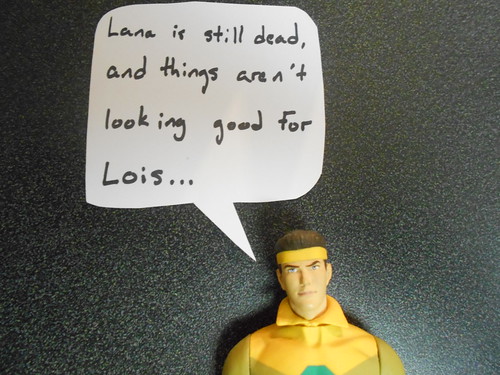
He's not kidding:
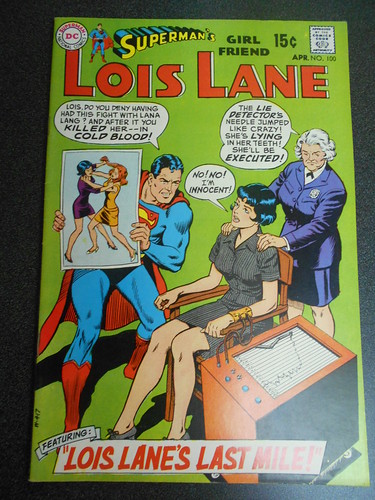
Also, how is it possible for Lois to be lying in her teeth? I've heard of lying through your teeth, but in them? Is that somehow worse than regular lying?
There's no time to dwell on it, because the trial starts with a parade of witnesses from Superman:

Batman, proving that there's some thing he's not good at after all, can't manage to poke a hole in any of their stories. Noting the obvious inability of her Bat-lawyer to save her, Superman calls a recess and tries to convince Lois to take a plea bargain:
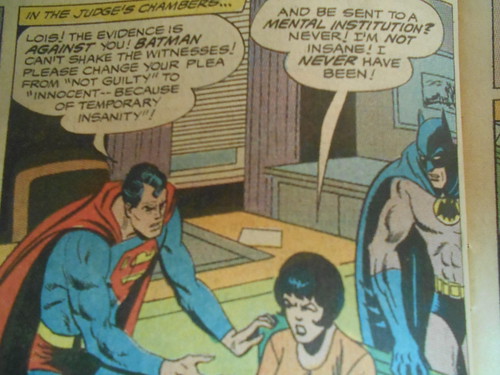
Pardon me while I guffaw.
You've never been insane, Lois? Never?
Correct me if I'm wrong, but this is issue #100 of Lois' comic. That means I can think of at least 99 examples of times when Lois was fully, completely, and sometimes homicidally insane. Superman starts providing examples, because finding a time when Lois was insane is about as difficult as finding a joint in the lawn seats at a Dave Matthews concert in Colorado, and Bat-lawyer shuts him down and rejects the plea deal.
Then Bat-lawyer does something that should immediately qualify him for Bat-disbarment: He puts Lois on the stand to defend herself.
Superman responds by destroying her:
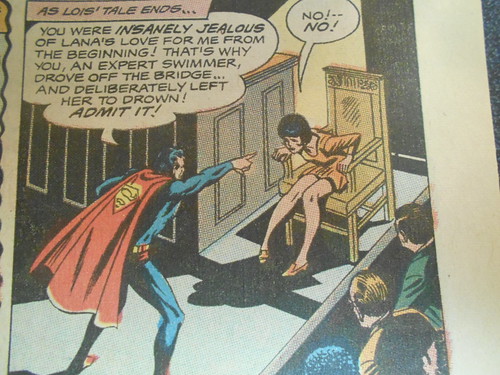
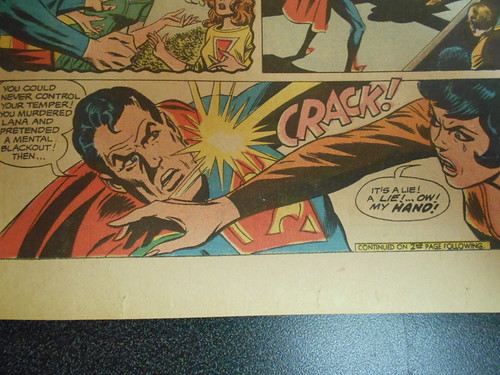
She seems totally innocent, right?
And also not insane?
Recognizing that she just punched her freedom to death, Lois offers to take a lie detector test. Bat-lawyer, in a continuing show of incompetence, fails to object.
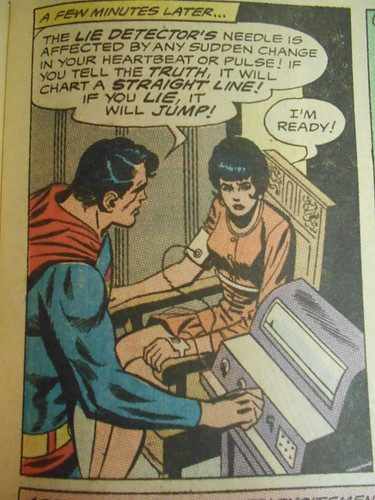

Nobody saw that coming, right?

Batman, remember the Top Chef Season 3 Holiday Special, when Betty Fraser, hateful cheftestant from Season 2, stared at the camera in panic over the top of her overcooked dinner course and blurted helplessly, "You can't uncook lamb!" You can't uncook lamb, Batman, and you can't unring a bell. The jury isn't going to forget the lie detector even if the judge tells them to. The time to object was before Lois got hooked up to it.
Realizing that he's the worst lawyer ever and has completely blown this case (although, really, it's not like Lois helped by jumping out of the witness box to slap Superman across the mouth), Batman resorts to one last tactic:

Dragging Lana's days-old (but still with great hair) corpse into the courtroom.
And here's where this tale of death goes completely off the rails, even by Lois Lane standards.
For starters, it's not Lana:
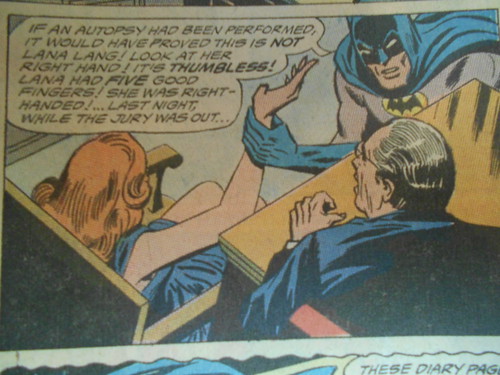
Batman knows, because he and Superman dug her up last night:
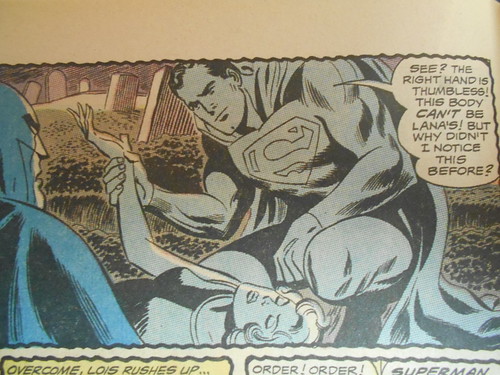
But then, who is it?
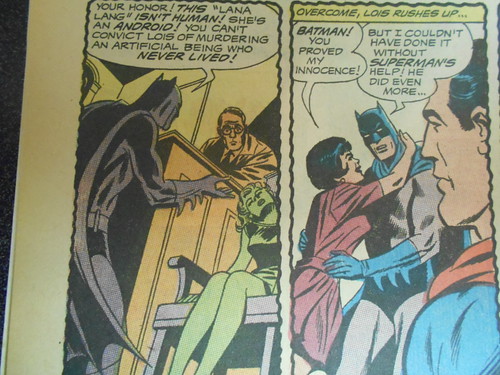
For reasons which are unclear, Superman's solution is to build a Lois android:

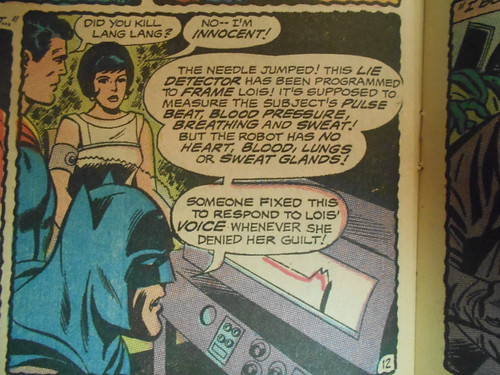
Wouldn't it have been easier just to inspect the lie detector?
I think Superman just wanted to build a robot.
After examining the Lana-bot, Superman traces its origin to the Sahara desert, where he discovers a domed spaceship with a giant chessboard:
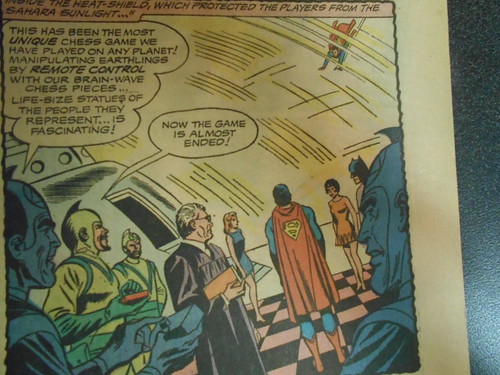
Aliens framed Lois, as part of some sort of chess game. Why? Oh, they never explain. They're too busy getting punched out by Superman, who rescues Lana:
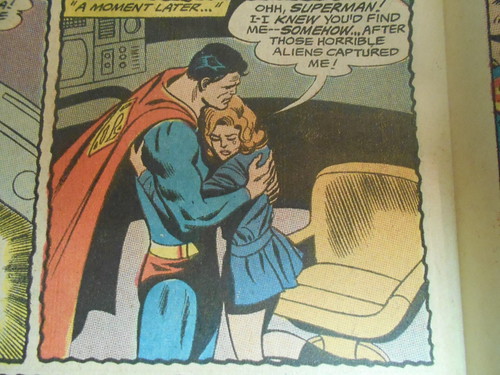
who is quick to find the silver lining:

Drop her, Superman. Just leave her in the desert, let Lois get convicted of murder, and go marry Wonder Woman, a nice sweet lady who isn't insane.
Superman instead takes her back to the courtroom, where Lois is cleared of all charges and only one question remains:
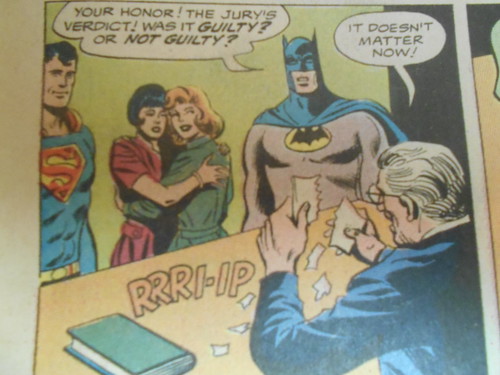
I bet she was guilty.
Happy Easter.



He's not kidding:

Also, how is it possible for Lois to be lying in her teeth? I've heard of lying through your teeth, but in them? Is that somehow worse than regular lying?
There's no time to dwell on it, because the trial starts with a parade of witnesses from Superman:

Batman, proving that there's some thing he's not good at after all, can't manage to poke a hole in any of their stories. Noting the obvious inability of her Bat-lawyer to save her, Superman calls a recess and tries to convince Lois to take a plea bargain:

Pardon me while I guffaw.
You've never been insane, Lois? Never?
Correct me if I'm wrong, but this is issue #100 of Lois' comic. That means I can think of at least 99 examples of times when Lois was fully, completely, and sometimes homicidally insane. Superman starts providing examples, because finding a time when Lois was insane is about as difficult as finding a joint in the lawn seats at a Dave Matthews concert in Colorado, and Bat-lawyer shuts him down and rejects the plea deal.
Then Bat-lawyer does something that should immediately qualify him for Bat-disbarment: He puts Lois on the stand to defend herself.
Superman responds by destroying her:


She seems totally innocent, right?
And also not insane?
Recognizing that she just punched her freedom to death, Lois offers to take a lie detector test. Bat-lawyer, in a continuing show of incompetence, fails to object.


Nobody saw that coming, right?

Batman, remember the Top Chef Season 3 Holiday Special, when Betty Fraser, hateful cheftestant from Season 2, stared at the camera in panic over the top of her overcooked dinner course and blurted helplessly, "You can't uncook lamb!" You can't uncook lamb, Batman, and you can't unring a bell. The jury isn't going to forget the lie detector even if the judge tells them to. The time to object was before Lois got hooked up to it.
Realizing that he's the worst lawyer ever and has completely blown this case (although, really, it's not like Lois helped by jumping out of the witness box to slap Superman across the mouth), Batman resorts to one last tactic:

Dragging Lana's days-old (but still with great hair) corpse into the courtroom.
And here's where this tale of death goes completely off the rails, even by Lois Lane standards.
For starters, it's not Lana:

Batman knows, because he and Superman dug her up last night:

But then, who is it?

For reasons which are unclear, Superman's solution is to build a Lois android:


Wouldn't it have been easier just to inspect the lie detector?
I think Superman just wanted to build a robot.
After examining the Lana-bot, Superman traces its origin to the Sahara desert, where he discovers a domed spaceship with a giant chessboard:

Aliens framed Lois, as part of some sort of chess game. Why? Oh, they never explain. They're too busy getting punched out by Superman, who rescues Lana:

who is quick to find the silver lining:

Drop her, Superman. Just leave her in the desert, let Lois get convicted of murder, and go marry Wonder Woman, a nice sweet lady who isn't insane.
Superman instead takes her back to the courtroom, where Lois is cleared of all charges and only one question remains:

I bet she was guilty.
Happy Easter.
Easter Morning Lois Lanesanity - Part 1
I know that yesterday I said that I would post twice for missing Friday's blog entry, but I decided to hold off until today, because I have a fantastic story of death and resurrection to share this Easter.
It's also a story of insanity.
Let's jump right in, shall we?
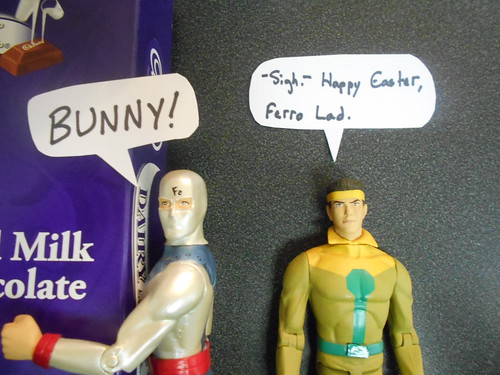
Ferro Lad, like me, is only happy about solid bunnies. We both understand that hollow bunnies are lies. They promise that they are thick, delicious chocolate, but then you bite and they explode into shards. Shards of lies. Chocolate lies.
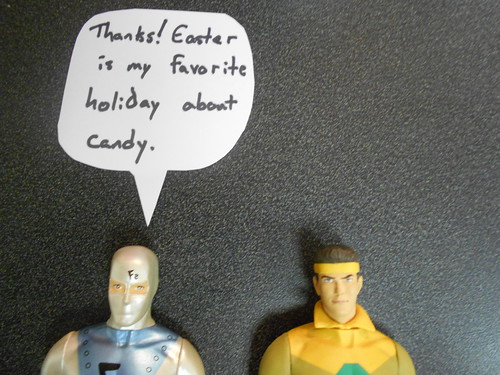


Like nobody saw that coming.

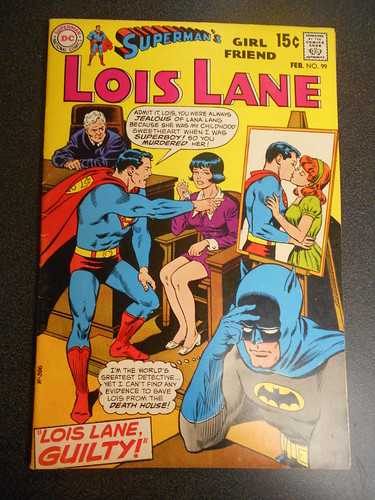
Our story opens with Lois, as is often the case, babbling something about herself at Clark while he wishes that there was a horrible emergency somewhere that needed responding to.

Lois is excited to be on this television show about Superman and his secret life, until she discovers that she's not the only one who might know about Superman's secrets:

Lana's eyebrows are not those of a friend who's happy to see you. Sensing animosity, the host immediately begins poking the hornet's nest of jealousy with a stick. He's a brave, brave man.
Lana, slightly less insane than Lois, attempts to take the high road:
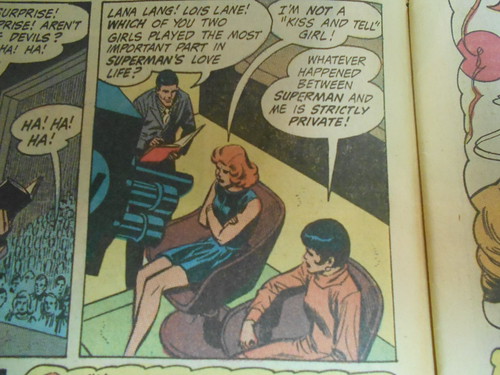
but the host immediately begins dredging up the past:
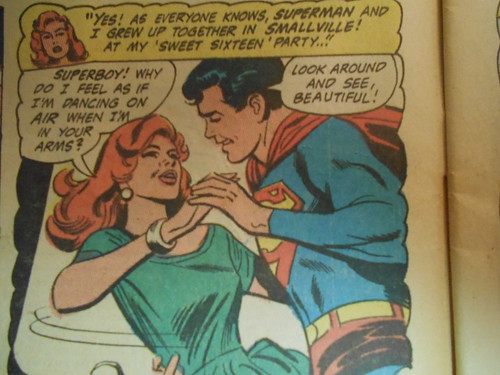
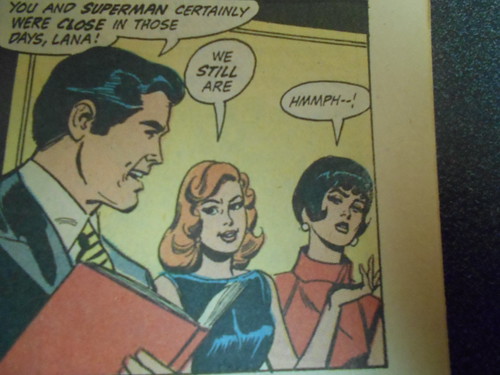
Before Lois can do more than hmmph, though, he goes right back to poking:
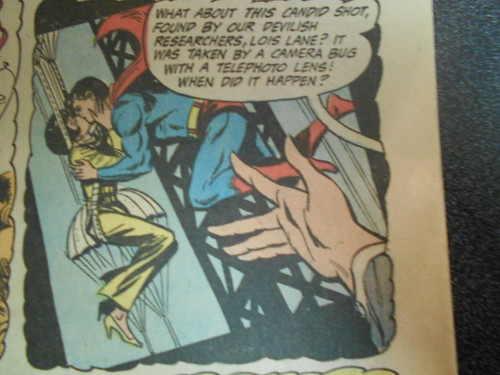
which ends up going about how these things usually go. Lois and Lana get mad, but still decide to go get some lunch together, because they are the original Best Frenemies.
Lunch quickly turns sour:
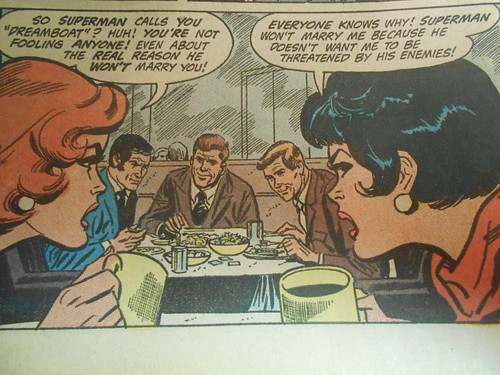
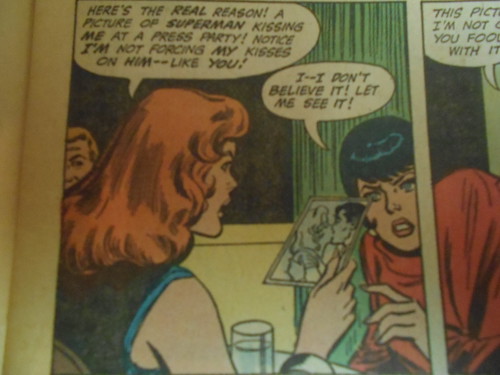
and then the hair-pulling starts:
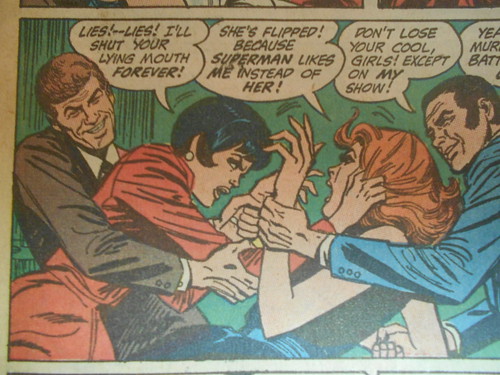
And, of course, the one threating murder is Lois. As I said, Lana is the slightly more sane of the two, although in this pair that's like being the slightly less burning log in the fireplace. Still, faster than you can say, "Violent, irrational mood swing," Lois is calling to apologize:

She wants to take Lana on a drive.
Alone.
In the rain.
On a bridge.
You see where this is going, right?
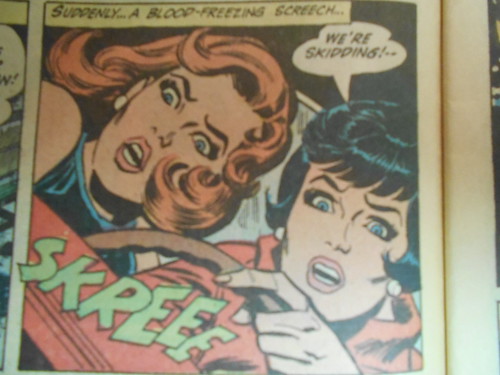
And off the bridge they go.
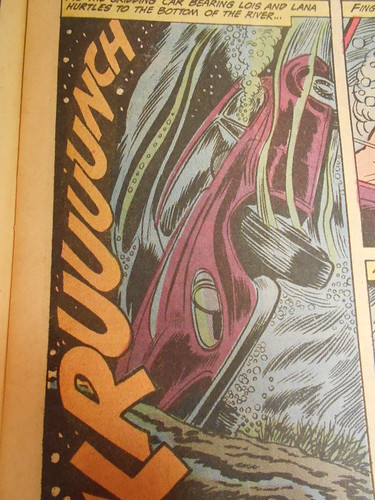
Lois, as good a friend as she is a driver, hauls herself out of the river without bothering to check on Lana, and hitchhikes back to her hotel, just in time for Superman to show up:
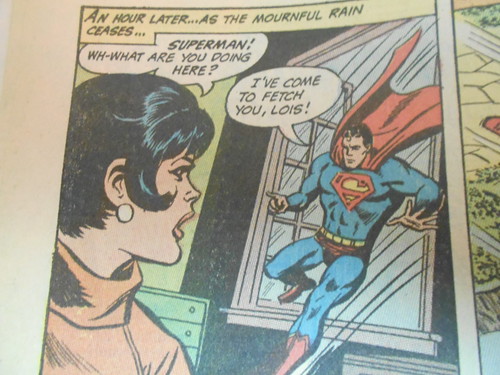
The police are trying to recover her car, and asked Superman to check on her. They're having a little trouble, though:
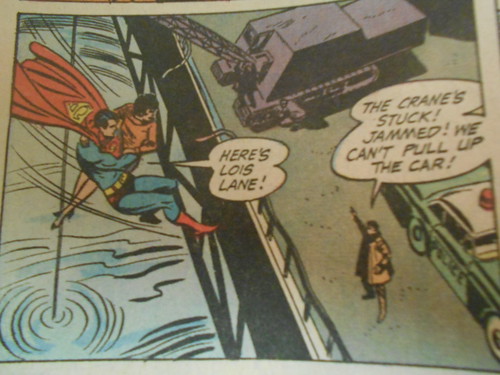
And then we all see what Lois has done:
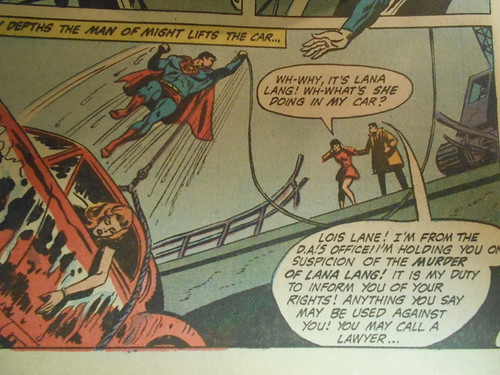
Lana's dead. And she still has great hair.
What follows is a scene so horribly written that I couldn't take pictures of it. I was too busy face-palming.
Lois ends up in the county lockup, where she is visited by Bruce Wayne. Bruce informs her that he's got the perfect lawyer for her, if she'll just wait right here in this room while he goes to another room to get the lawyer. Bruce leaves and then Batman comes in, because Bruce Wayne is Batman and Batman is Lois' lawyer and HOW THE HELL DID NO ONE EVER FIGURE OUT BATMAN AND SUPERMAN'S IDENTITIES WHEN THIS IS THE BEST THEY DID TO COVER THEM?
Superman joins them with some terrible news:
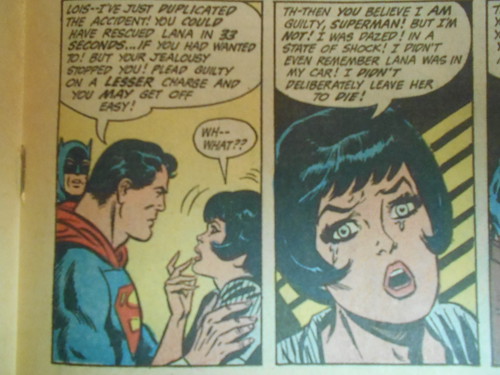
So, Lois is going with the Ted Kennedy defense, then. Who knew that the writing pool at DC Comics was following the "Law and Order" "ripped from the headlines!" school of plot construction? I'm not just being facetious in bringing that up, either. This comic is from February 1970. Chappaquiddick was barely months old at that point, and probably still in the newspapers.
Getting back to the story, Superman informs Lois and Batman that he'll be serving as the prosecutor, since Batman's skills as defense attorney require super skills on the other side of the aisle as well. Also, you know, Lois killed his other girlfriend, so he's a little upset.
Lois, being Lois, immediately starts ignoring the advice of her lawyer and making things worse for herself:
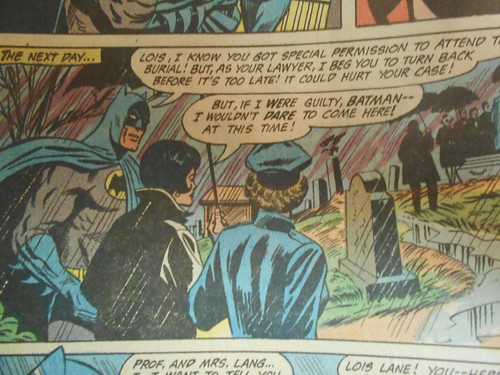
and the Langs are, not surprisingly, not at all happy to see her:
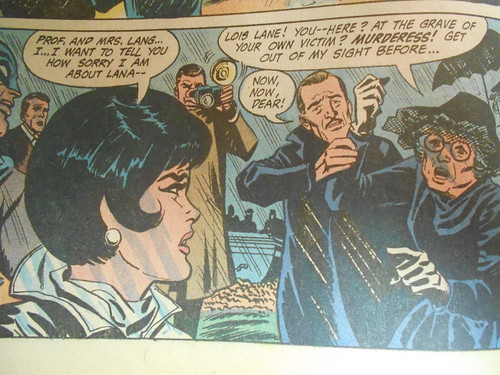
And that's where we leave things, for now. Lana's dead, Lois is going to stand trial:
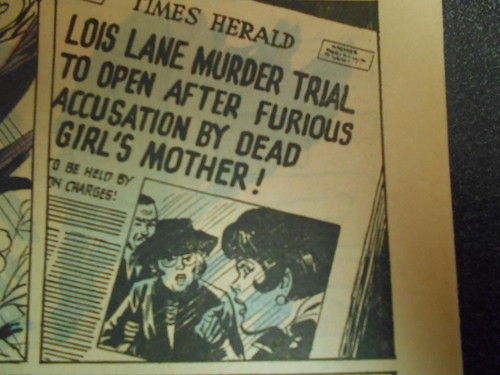
and I'm going to go eat some of Ferro Lad's chocolate bunny.
It's also a story of insanity.
Let's jump right in, shall we?

Ferro Lad, like me, is only happy about solid bunnies. We both understand that hollow bunnies are lies. They promise that they are thick, delicious chocolate, but then you bite and they explode into shards. Shards of lies. Chocolate lies.



Like nobody saw that coming.


Our story opens with Lois, as is often the case, babbling something about herself at Clark while he wishes that there was a horrible emergency somewhere that needed responding to.

Lois is excited to be on this television show about Superman and his secret life, until she discovers that she's not the only one who might know about Superman's secrets:

Lana's eyebrows are not those of a friend who's happy to see you. Sensing animosity, the host immediately begins poking the hornet's nest of jealousy with a stick. He's a brave, brave man.
Lana, slightly less insane than Lois, attempts to take the high road:

but the host immediately begins dredging up the past:


Before Lois can do more than hmmph, though, he goes right back to poking:

which ends up going about how these things usually go. Lois and Lana get mad, but still decide to go get some lunch together, because they are the original Best Frenemies.
Lunch quickly turns sour:


and then the hair-pulling starts:

And, of course, the one threating murder is Lois. As I said, Lana is the slightly more sane of the two, although in this pair that's like being the slightly less burning log in the fireplace. Still, faster than you can say, "Violent, irrational mood swing," Lois is calling to apologize:

She wants to take Lana on a drive.
Alone.
In the rain.
On a bridge.
You see where this is going, right?

And off the bridge they go.

Lois, as good a friend as she is a driver, hauls herself out of the river without bothering to check on Lana, and hitchhikes back to her hotel, just in time for Superman to show up:

The police are trying to recover her car, and asked Superman to check on her. They're having a little trouble, though:

And then we all see what Lois has done:

Lana's dead. And she still has great hair.
What follows is a scene so horribly written that I couldn't take pictures of it. I was too busy face-palming.
Lois ends up in the county lockup, where she is visited by Bruce Wayne. Bruce informs her that he's got the perfect lawyer for her, if she'll just wait right here in this room while he goes to another room to get the lawyer. Bruce leaves and then Batman comes in, because Bruce Wayne is Batman and Batman is Lois' lawyer and HOW THE HELL DID NO ONE EVER FIGURE OUT BATMAN AND SUPERMAN'S IDENTITIES WHEN THIS IS THE BEST THEY DID TO COVER THEM?
Superman joins them with some terrible news:

So, Lois is going with the Ted Kennedy defense, then. Who knew that the writing pool at DC Comics was following the "Law and Order" "ripped from the headlines!" school of plot construction? I'm not just being facetious in bringing that up, either. This comic is from February 1970. Chappaquiddick was barely months old at that point, and probably still in the newspapers.
Getting back to the story, Superman informs Lois and Batman that he'll be serving as the prosecutor, since Batman's skills as defense attorney require super skills on the other side of the aisle as well. Also, you know, Lois killed his other girlfriend, so he's a little upset.
Lois, being Lois, immediately starts ignoring the advice of her lawyer and making things worse for herself:

and the Langs are, not surprisingly, not at all happy to see her:

And that's where we leave things, for now. Lana's dead, Lois is going to stand trial:

and I'm going to go eat some of Ferro Lad's chocolate bunny.
Saturday, April 19, 2014
Squeeze out some breakfast
Last night at about eleven I thought, "Hey, I'm still awake." This is an achievement, because I am old. I also thought, "Crap. I forgot to write anything for Day 18 of 30 Days of Blogging. I failed. I am a failure. I am incapable of meeting goals. No wonder I don't have a boyfriend. Or a pet. Or a plant," and then I took a deep breath and thought, "OK, Norma Desmond, let's reel in the dramatics just a little." To make up for skipping yesterday, I decided to write two entries today.
So, on Part 1 of Day 19 of 30 Days of Blogging, I'm going to talk about the horrifying breakfast I ate this morning, which was inspired by my Alternative Spring Break trip last year. On one of the days of that trip, we worked at the Capital Area Food Bank warehouse, spending a few hours sorting food donations. During part of that time, a few of us ended up sorting baby food to check all of the expiration dates, and that's where we encountered this:
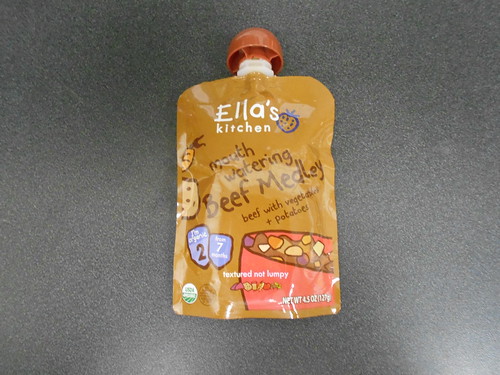
Liquid beef.
Trey, Eric, and I stared at it in confusion and mild horror.
"That's beef and vegetables?"
"How is that even possible?"
"It feels like jelly. Like, there aren't any lumps at all."
"Do they just make beef stew and throw it in a blender?"
"What do you think it tastes like?"
That's the real question, isn't it? The one you wonder about most of all? Because really, if they can make beef and vegetables into something that you can squeeze out of a pouch to feed to a toothless child, then what does that do to the flavor?
This whole discussion occurred to me again last week in the grocery store. I was out west at the Kroger that has furniture and housewares, not my regular Kroger that just has groceries like a grocery store should, and I somehow ended up on the baby food aisle when I was looking for pasta instead. While trying to figure out how to get to food that I might actually eat, I noticed the pouch of beef and thought, "You know, I could just buy one and eat it."
So I bought it.
And this morning I ate it.
It turns out to be oddly tasteless, but it has a smell, something like cat food. It's not an appetizing smell, but maybe it smells differently to babies. The real issue with this, at least for me, wasn't the smell, the taste, or the slightly gritty texture. It was the visual.
Beef from a pouch looks like poop.

A lot like poop.

Like this will look exactly the same coming out of your baby as it does going in.
I'm sure babies like it, though.
So, on Part 1 of Day 19 of 30 Days of Blogging, I'm going to talk about the horrifying breakfast I ate this morning, which was inspired by my Alternative Spring Break trip last year. On one of the days of that trip, we worked at the Capital Area Food Bank warehouse, spending a few hours sorting food donations. During part of that time, a few of us ended up sorting baby food to check all of the expiration dates, and that's where we encountered this:

Liquid beef.
Trey, Eric, and I stared at it in confusion and mild horror.
"That's beef and vegetables?"
"How is that even possible?"
"It feels like jelly. Like, there aren't any lumps at all."
"Do they just make beef stew and throw it in a blender?"
"What do you think it tastes like?"
That's the real question, isn't it? The one you wonder about most of all? Because really, if they can make beef and vegetables into something that you can squeeze out of a pouch to feed to a toothless child, then what does that do to the flavor?
This whole discussion occurred to me again last week in the grocery store. I was out west at the Kroger that has furniture and housewares, not my regular Kroger that just has groceries like a grocery store should, and I somehow ended up on the baby food aisle when I was looking for pasta instead. While trying to figure out how to get to food that I might actually eat, I noticed the pouch of beef and thought, "You know, I could just buy one and eat it."
So I bought it.
And this morning I ate it.
It turns out to be oddly tasteless, but it has a smell, something like cat food. It's not an appetizing smell, but maybe it smells differently to babies. The real issue with this, at least for me, wasn't the smell, the taste, or the slightly gritty texture. It was the visual.
Beef from a pouch looks like poop.

A lot like poop.

Like this will look exactly the same coming out of your baby as it does going in.
I'm sure babies like it, though.
Thursday, April 17, 2014
Smoke Isn't Supposed to Come Out of That
Tonight, on Day 17 of 30 Days of Blogging, my Little Oscar countertop food processor died.
And by "died", I mean that it made a grinding noise while it was processing. And then smoke started to come out of it. Then I turned it off, unplugged it, and drowned it in the bathtub in case it was smoldering inside. I now feel like it's safe to put it in the dumpster without running the risk of starting a trash fire and burning the building down, so I'll do that later.
Before drowning it, I removed the bowl and saved my food. See, "Mad Men" is on this Sunday, and last week while watching a horribly depressing episode that made me wonder why I watch "Mad Men" I thought, "Wouldn't it be awesome if I had some snacks?" as if those would somehow distract me from the soul crushing agony that everyone on that show seems to live in so far this season. I thought about it all week, and decided that I would like to make a nice Bacon Ranch Cheeseball, and then eat it with crackers and maybe make some drinks while I watch Joan wear fabulous outfits and wait for everyone else on the show to die.
I picked up the ingredients the other day, and when I got home tonight I decided to blend up the cheeseball now, so that it could sit for a couple of days and let the flavors blend a little. I don't remember where I got this recipe, but it barely counts as one. There's not much to it:
Bacon Ranch Cheeseball
2 bricks low fat cream cheese (DON'T get fat free; the consistency is weird)
1/2 cup shredded cheddar
1 packet ranch dressing mix
1/4 cup bacon bits or cooked crumbled bacon
Extra bacon bits or parsley to roll cheese ball in (I skip this step and just put the cheeseball mixture into some Gladware)
1) Place first four ingredients in food processor.
2) Process the hell out of it until it is fully blended.
3) If planning to actually make a ball, put it in the fridge to firm up for a couple hours. Take it out, put a Ziploc baggie on each hand, and use your hands to shape it into a ball. Then roll it in the parsley or bacon until it's covered, put it on a plate, and serve with crackers.
See?
Super easy, until your food processor dies.
I guess I'm going shopping this weekend.
And by "died", I mean that it made a grinding noise while it was processing. And then smoke started to come out of it. Then I turned it off, unplugged it, and drowned it in the bathtub in case it was smoldering inside. I now feel like it's safe to put it in the dumpster without running the risk of starting a trash fire and burning the building down, so I'll do that later.
Before drowning it, I removed the bowl and saved my food. See, "Mad Men" is on this Sunday, and last week while watching a horribly depressing episode that made me wonder why I watch "Mad Men" I thought, "Wouldn't it be awesome if I had some snacks?" as if those would somehow distract me from the soul crushing agony that everyone on that show seems to live in so far this season. I thought about it all week, and decided that I would like to make a nice Bacon Ranch Cheeseball, and then eat it with crackers and maybe make some drinks while I watch Joan wear fabulous outfits and wait for everyone else on the show to die.
I picked up the ingredients the other day, and when I got home tonight I decided to blend up the cheeseball now, so that it could sit for a couple of days and let the flavors blend a little. I don't remember where I got this recipe, but it barely counts as one. There's not much to it:
Bacon Ranch Cheeseball
2 bricks low fat cream cheese (DON'T get fat free; the consistency is weird)
1/2 cup shredded cheddar
1 packet ranch dressing mix
1/4 cup bacon bits or cooked crumbled bacon
Extra bacon bits or parsley to roll cheese ball in (I skip this step and just put the cheeseball mixture into some Gladware)
1) Place first four ingredients in food processor.
2) Process the hell out of it until it is fully blended.
3) If planning to actually make a ball, put it in the fridge to firm up for a couple hours. Take it out, put a Ziploc baggie on each hand, and use your hands to shape it into a ball. Then roll it in the parsley or bacon until it's covered, put it on a plate, and serve with crackers.
See?
Super easy, until your food processor dies.
I guess I'm going shopping this weekend.
Wednesday, April 16, 2014
The Starfish
On Day 16 of 30 Days of Blogging, I offer a topic a friend sent me in a private message on Facebook:
You were never this vocal about being gay and issues facing gay people when you lived in New York. What changed when you moved to Tennessee?
This is an interesting question. Basically, there's a short answer, and there's a longer and more complicated one.
Short answer: In New York, there were lots of gay people, and lots of gay advocates, and lots of people working on LGBT rights. I had the luxury of being a small part of a large group, and the burden of work in moving LGBT rights forward was already being done by other, more motivated people. Then I moved here, and I was suddenly a part of a much smaller group. This much smaller group was, and is, often overlooked, and it became apparent that if I did not speak sometimes, then sometimes there would be no one speaking. "Sometimes" became "a lot of the time", and I guess somewhere in there I turned into an advocate. I'm not the only one on campus, but there definitely aren't as many of us as there need to be.
Longer answer: This leads to a simple question: Why do there need to be advocates for LGBT people at all?
To answer that question, I have to repeat a story that I never really liked before I moved here. During my first year as a hall director, one of my supervisors was really, really into this story, so I heard it over and over and over, and can now type it from memory:
A man is out walking along the beach in the morning as the sun rises, and sees a young woman walking along the waterline. She appears to be dancing, bending and spinning on the sand, and as he gets closer he sees that she seems to be throwing something into the ocean.
"What are you doing?" he asks.
She bends over, picks up a starfish, and throws it into the water.
"I'm throwing the starfish back into the ocean. When the tide went out, they were stranded on the beach, and when the sun comes up they will dry out and die."
The man scoffs.
"Young woman, there are thousands of miles of beach, and millions of starfish. How can what you're doing possibly matter?"
The young woman shrugged and picked up another starfish, holding it out to him before throwing it back into the ocean.
"It matters to this one."
I always thought that story was crap, honestly. A bunch of huggy, possibly hippy crap that people like my supervisor printed on posters and hung in their offices next to a full product line of motivational decorations from the Successories catalog. It's one of those stories about how little things make a big difference and the smallest action can impact lives in powerful ways, and I was young and cynical and knew everything, as young and cynical people often do, and I certainly knew bullshit when I heard it.
And then, eventually, I moved to Tennessee.
And I met a starfish.
In the time that I have worked here, five students have told me that I am the first out gay male that they have ever spoken to. Growing up in New York, even in conservative "red state" northern New York, this was initially incomprehensible to me, but it's true. They've probably met some closeted gay men, but out gay men are in short supply on this campus.
And why is it so important to meet out gay people?
Because it lets everyone know that we are people.
For years, polling data has shown that knowing a gay person affects your stance on gay rights. It's very easy to discriminate against "those people"; it's hopefully a little more difficult to discriminate against Joel, the guy you had lunch with yesterday. (Unless our lunch was horrible.) It helps us find allies, which we desperately need in order to move forward toward equality. It helps us find support groups, which we also need when we end up moving backwards instead. Meeting gay people humanizes gay people, and moves us toward the day when we can all just be people without another qualifier in front of it.
Getting back to the starfish, there's also a reason why it can mean so much to an individual student. It's one thing to tell people that it gets better, but it's another thing entirely to show them. We set our self-worth and our self-image by the things we see around us. How do you assign a value to yourself as a gay teenager if you never see any other gay people? How do you know what a normal gay relationship should look like if you never encounter one? How do you know that things will be better when you're an adult if you never meet a gay adult? One student told me that, as a gay male who was also an administrator at this school, I was like a magical unicorn that they couldn't believe they'd seen. That student has graduated and now works in college administration.
It mattered to that one, so it matters to me.
You were never this vocal about being gay and issues facing gay people when you lived in New York. What changed when you moved to Tennessee?
This is an interesting question. Basically, there's a short answer, and there's a longer and more complicated one.
Short answer: In New York, there were lots of gay people, and lots of gay advocates, and lots of people working on LGBT rights. I had the luxury of being a small part of a large group, and the burden of work in moving LGBT rights forward was already being done by other, more motivated people. Then I moved here, and I was suddenly a part of a much smaller group. This much smaller group was, and is, often overlooked, and it became apparent that if I did not speak sometimes, then sometimes there would be no one speaking. "Sometimes" became "a lot of the time", and I guess somewhere in there I turned into an advocate. I'm not the only one on campus, but there definitely aren't as many of us as there need to be.
Longer answer: This leads to a simple question: Why do there need to be advocates for LGBT people at all?
To answer that question, I have to repeat a story that I never really liked before I moved here. During my first year as a hall director, one of my supervisors was really, really into this story, so I heard it over and over and over, and can now type it from memory:
A man is out walking along the beach in the morning as the sun rises, and sees a young woman walking along the waterline. She appears to be dancing, bending and spinning on the sand, and as he gets closer he sees that she seems to be throwing something into the ocean.
"What are you doing?" he asks.
She bends over, picks up a starfish, and throws it into the water.
"I'm throwing the starfish back into the ocean. When the tide went out, they were stranded on the beach, and when the sun comes up they will dry out and die."
The man scoffs.
"Young woman, there are thousands of miles of beach, and millions of starfish. How can what you're doing possibly matter?"
The young woman shrugged and picked up another starfish, holding it out to him before throwing it back into the ocean.
"It matters to this one."
I always thought that story was crap, honestly. A bunch of huggy, possibly hippy crap that people like my supervisor printed on posters and hung in their offices next to a full product line of motivational decorations from the Successories catalog. It's one of those stories about how little things make a big difference and the smallest action can impact lives in powerful ways, and I was young and cynical and knew everything, as young and cynical people often do, and I certainly knew bullshit when I heard it.
And then, eventually, I moved to Tennessee.
And I met a starfish.
In the time that I have worked here, five students have told me that I am the first out gay male that they have ever spoken to. Growing up in New York, even in conservative "red state" northern New York, this was initially incomprehensible to me, but it's true. They've probably met some closeted gay men, but out gay men are in short supply on this campus.
And why is it so important to meet out gay people?
Because it lets everyone know that we are people.
For years, polling data has shown that knowing a gay person affects your stance on gay rights. It's very easy to discriminate against "those people"; it's hopefully a little more difficult to discriminate against Joel, the guy you had lunch with yesterday. (Unless our lunch was horrible.) It helps us find allies, which we desperately need in order to move forward toward equality. It helps us find support groups, which we also need when we end up moving backwards instead. Meeting gay people humanizes gay people, and moves us toward the day when we can all just be people without another qualifier in front of it.
Getting back to the starfish, there's also a reason why it can mean so much to an individual student. It's one thing to tell people that it gets better, but it's another thing entirely to show them. We set our self-worth and our self-image by the things we see around us. How do you assign a value to yourself as a gay teenager if you never see any other gay people? How do you know what a normal gay relationship should look like if you never encounter one? How do you know that things will be better when you're an adult if you never meet a gay adult? One student told me that, as a gay male who was also an administrator at this school, I was like a magical unicorn that they couldn't believe they'd seen. That student has graduated and now works in college administration.
It mattered to that one, so it matters to me.
Tuesday, April 15, 2014
The Pyrex
On Day 15, halfway through 30 Days of Blogging, I've decided that it's time to talk about the Pyrex.
Several of my friends asked about the Pyrex, some in the serious sense and some in the mocking sense. My friends talk about the Pyrex a lot, because I talk about the Pyrex a lot when I get a new piece or when someone asks me about it. Some of my friends also collect the Pyrex. Some of my friends don't collect the Pyrex, but they look for it for me when they are out and about. And some of my friends crack jokes about the Pyrex and how I will die buried beneath a collapsed hoard of Pyrex, my mummified corpse dried into the carpet beneath a stack of Town and Country or Early American lidded round casserole dishes.
Here's the thing: I was going to write a long, ranting entry about how I don't judge your habits and I don't mock your collections and I don't make fun of the things that make you happy, but that isn't true. I do judge your habits. I judge the hell out of them. If you had a hobby of collecting antique buckets from wishing wells, and every couple weeks there was a new picture of an antique bucket from a wishing well on your Facebook feed along with a two paragraph explanation of how this particular bucket was only available for six months in 1961 and was originally sold with a knotted rope handle and a tin ladle, you can bet your sweet ass I would make fun of you. Even though I'm your friend. Actually, especially because I'm your friend.
So I get it.
Everyone doesn't get the Pyrex.
I didn't always get it, either.
Two of my first three pieces of Pyrex are in this picture:
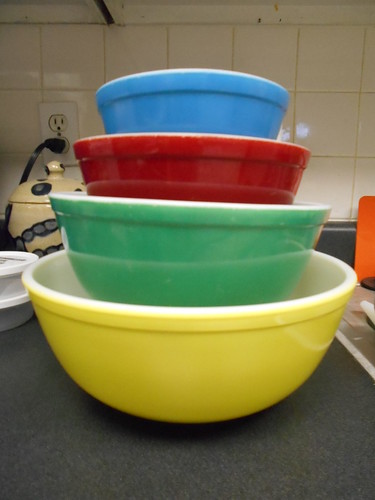
The green bowl and the yellow bowl (Primary Colors set #403 and 404, respectively, even though green isn't a primary color), along with a duplicate yellow bowl, were inherited from my father's mother. When we packed her up to put her in The Home, a traumatic day in which my uncle wept, I had to carry a bucket of human feces upstairs, my mom had to clean a bucket of human feces, and my dad encouraged me to do a couple of shots of leftover wedding souvenir bottles (my maudlin, useless uncle, who claimed that those bottles represented people's lives, was assured that I would only drink the ones from weddings which had ended in divorce), she told us between puffs of her cigarette to take whatever we wanted from the house. I was a little light on kitchenware, so I took an entire set of engraved barware, some appetizer plates, a few dishtowels and wooden spoons, and the three Pyrex bowls. At the time, I had no idea they were anything special. I just needed some big mixing bowls, and they appeared serviceable.
I used them pretty regularly over the next few years, and then a few years ago my parents came to visit me, and I took them to all of my favorite places in Knoxville, which included a few vintage and antique stores. At one of them, my mom noticed a small Pyrex dish that she thought might interest her friend Cheryl. When she got home she told Cheryl about it, and Cheryl was interested, but Mom didn't buy the dish and couldn't show it to her. Mom called me and had me go back for it, and then gave it to Cheryl for Christmas.
"By the way," Mom said casually. "If you see another one, I might like one, too."
And so I started looking for another. Each time I went thrifting or antiquing, I would look for Pyrex, to see if they had another dish like the one we got for Cheryl. Every once in a while, I picked a random dish up for myself, a round open baking dish here, a covered hostess dish there, with no real thought behind it. Then I got curious. I started reading online about patterns, prices, and rarity. Cheryl invited Mom and I to a Facebook group for collectors, and I invited my friend Heather, who collects much more than I do. People talked about Pyrex, and posted photos of their finds and their collections, and I started to look at my dishes and think, "Well, I have two pieces of that set. Maybe I could get the rest."
There were two finds that really pushed me from casual to somewhat deliberate collecting.
The first was the "ugly brown dishes":
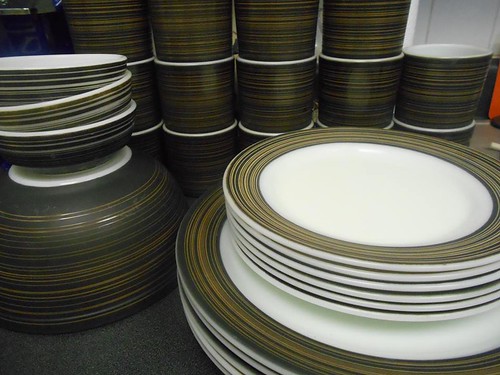
My friend and I were at an estate sale, and one of the ladies working the sale was trying to sell me the yellow, red, and green bowls from the set up at the beginning of the entry as a group for sixty dollars. Since I already had two yellows and a green, I really wasn't interested, and asked what other dishware was in the house.
"There's a set of ugly brown dishes in the kitchen, and some other stuff."
My friend, who collects certain china patterns, and I headed into the kitchen, and I immediately stopped and gaped.
"Those are Terra. An entire set."
I flagged down a worker immediately and had her mark the set as sold, without hesitation. That set has 14 coffee cups. Right now, a set of 4 of those is selling at an antique store down the street for twenty five dollars. There are five 13 inch chop plates, which normally sell for eight to ten dollars each. I paid eight dollars for one a couple months ago to make this set have an even number. The big mixing bowl is a 403, which goes for ten to twenty dollars by itself. I picked up the entire set for thirty five dollars, and started thinking about how I needed to finish it.
The second piece that pushed me all the way into collecting was the Golden Hearts Casserole:
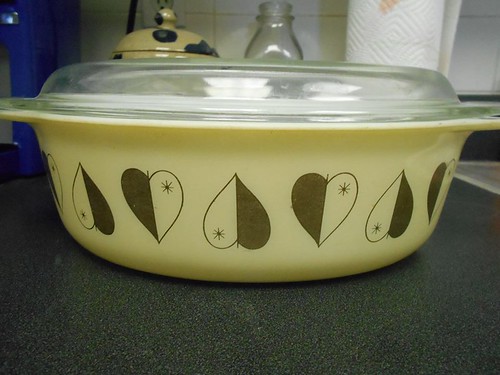
In addition to patterned sets, Pyrex made dozens of promotional pieces over the years, bowls and casseroles that had a unique pattern or color and were only offered for a limited time. The people in the Pyrex group were forever posting about finding all these unique and exciting pieces dirt cheap, and all I ever seemed to find was parts of sets. Sure, sets are exciting, but promotional pieces were special, and I didn't have any until I found that casserole dish on my way back from Nashville, and it was only five dollars.
And that was it.
I became a Pyrex collector.
I have limits, though. I only collect certain patterns, and I've never paid more than twenty dollars for a single dish. There are a few dishes in one of my closets, waiting to be displayed someday, a few on the top of the fridge, a few in my cabinets because I use them every day, and a few displayed on top of my cabinets:

Those are my full (or almost full) sets. From left to right:
Early American Cinderella mixing bowls - Cinderella bowls have a handle on each side, one of which is designed to also be a spout. The smallest bowl in that set, the 441, is with my parents, because I found it at a store while I was home for Christmas this year and was afraid it would get broken on the plane. They'll bring it in a few weeks when they drive down.
Early American round mixing bowls - I'm missing the largest one, the 404. The last one I saw on Etsy was fifty dollars.
Verde round mixing bowls - The greens are so pretty.
Tally Ho Cinderella bowl and Delphite 401 - There are no other sized Cinderella bowls in Tally Ho, and I don't anticipate ever finding any other Delphite bowls at a reasonable price, so those two are just sitting together.
Pink round mixing bowls - A yard sale find. You know who else used Pink Pyrex? Julia Child.
Terra round mixing bowls - Terra, for unknown reasons, doesn't include a 402 size, so my set has a weird gap in it even though it is complete.
Primary Colors round mixing bowls - Recently completed due to a gift of the red 402 from my friend Heather.
Next to those, I have an empty space. It's being held for a complete round Butterfly Gold set, which my Aunt Geri gave me for Christmas and which my parents are bringing down when they come.
So there. That's the Pyrex.
Now you tell me all about your antique buckets.
Several of my friends asked about the Pyrex, some in the serious sense and some in the mocking sense. My friends talk about the Pyrex a lot, because I talk about the Pyrex a lot when I get a new piece or when someone asks me about it. Some of my friends also collect the Pyrex. Some of my friends don't collect the Pyrex, but they look for it for me when they are out and about. And some of my friends crack jokes about the Pyrex and how I will die buried beneath a collapsed hoard of Pyrex, my mummified corpse dried into the carpet beneath a stack of Town and Country or Early American lidded round casserole dishes.
Here's the thing: I was going to write a long, ranting entry about how I don't judge your habits and I don't mock your collections and I don't make fun of the things that make you happy, but that isn't true. I do judge your habits. I judge the hell out of them. If you had a hobby of collecting antique buckets from wishing wells, and every couple weeks there was a new picture of an antique bucket from a wishing well on your Facebook feed along with a two paragraph explanation of how this particular bucket was only available for six months in 1961 and was originally sold with a knotted rope handle and a tin ladle, you can bet your sweet ass I would make fun of you. Even though I'm your friend. Actually, especially because I'm your friend.
So I get it.
Everyone doesn't get the Pyrex.
I didn't always get it, either.
Two of my first three pieces of Pyrex are in this picture:

The green bowl and the yellow bowl (Primary Colors set #403 and 404, respectively, even though green isn't a primary color), along with a duplicate yellow bowl, were inherited from my father's mother. When we packed her up to put her in The Home, a traumatic day in which my uncle wept, I had to carry a bucket of human feces upstairs, my mom had to clean a bucket of human feces, and my dad encouraged me to do a couple of shots of leftover wedding souvenir bottles (my maudlin, useless uncle, who claimed that those bottles represented people's lives, was assured that I would only drink the ones from weddings which had ended in divorce), she told us between puffs of her cigarette to take whatever we wanted from the house. I was a little light on kitchenware, so I took an entire set of engraved barware, some appetizer plates, a few dishtowels and wooden spoons, and the three Pyrex bowls. At the time, I had no idea they were anything special. I just needed some big mixing bowls, and they appeared serviceable.
I used them pretty regularly over the next few years, and then a few years ago my parents came to visit me, and I took them to all of my favorite places in Knoxville, which included a few vintage and antique stores. At one of them, my mom noticed a small Pyrex dish that she thought might interest her friend Cheryl. When she got home she told Cheryl about it, and Cheryl was interested, but Mom didn't buy the dish and couldn't show it to her. Mom called me and had me go back for it, and then gave it to Cheryl for Christmas.
"By the way," Mom said casually. "If you see another one, I might like one, too."
And so I started looking for another. Each time I went thrifting or antiquing, I would look for Pyrex, to see if they had another dish like the one we got for Cheryl. Every once in a while, I picked a random dish up for myself, a round open baking dish here, a covered hostess dish there, with no real thought behind it. Then I got curious. I started reading online about patterns, prices, and rarity. Cheryl invited Mom and I to a Facebook group for collectors, and I invited my friend Heather, who collects much more than I do. People talked about Pyrex, and posted photos of their finds and their collections, and I started to look at my dishes and think, "Well, I have two pieces of that set. Maybe I could get the rest."
There were two finds that really pushed me from casual to somewhat deliberate collecting.
The first was the "ugly brown dishes":

My friend and I were at an estate sale, and one of the ladies working the sale was trying to sell me the yellow, red, and green bowls from the set up at the beginning of the entry as a group for sixty dollars. Since I already had two yellows and a green, I really wasn't interested, and asked what other dishware was in the house.
"There's a set of ugly brown dishes in the kitchen, and some other stuff."
My friend, who collects certain china patterns, and I headed into the kitchen, and I immediately stopped and gaped.
"Those are Terra. An entire set."
I flagged down a worker immediately and had her mark the set as sold, without hesitation. That set has 14 coffee cups. Right now, a set of 4 of those is selling at an antique store down the street for twenty five dollars. There are five 13 inch chop plates, which normally sell for eight to ten dollars each. I paid eight dollars for one a couple months ago to make this set have an even number. The big mixing bowl is a 403, which goes for ten to twenty dollars by itself. I picked up the entire set for thirty five dollars, and started thinking about how I needed to finish it.
The second piece that pushed me all the way into collecting was the Golden Hearts Casserole:

In addition to patterned sets, Pyrex made dozens of promotional pieces over the years, bowls and casseroles that had a unique pattern or color and were only offered for a limited time. The people in the Pyrex group were forever posting about finding all these unique and exciting pieces dirt cheap, and all I ever seemed to find was parts of sets. Sure, sets are exciting, but promotional pieces were special, and I didn't have any until I found that casserole dish on my way back from Nashville, and it was only five dollars.
And that was it.
I became a Pyrex collector.
I have limits, though. I only collect certain patterns, and I've never paid more than twenty dollars for a single dish. There are a few dishes in one of my closets, waiting to be displayed someday, a few on the top of the fridge, a few in my cabinets because I use them every day, and a few displayed on top of my cabinets:

Those are my full (or almost full) sets. From left to right:
Early American Cinderella mixing bowls - Cinderella bowls have a handle on each side, one of which is designed to also be a spout. The smallest bowl in that set, the 441, is with my parents, because I found it at a store while I was home for Christmas this year and was afraid it would get broken on the plane. They'll bring it in a few weeks when they drive down.
Early American round mixing bowls - I'm missing the largest one, the 404. The last one I saw on Etsy was fifty dollars.
Verde round mixing bowls - The greens are so pretty.
Tally Ho Cinderella bowl and Delphite 401 - There are no other sized Cinderella bowls in Tally Ho, and I don't anticipate ever finding any other Delphite bowls at a reasonable price, so those two are just sitting together.
Pink round mixing bowls - A yard sale find. You know who else used Pink Pyrex? Julia Child.
Terra round mixing bowls - Terra, for unknown reasons, doesn't include a 402 size, so my set has a weird gap in it even though it is complete.
Primary Colors round mixing bowls - Recently completed due to a gift of the red 402 from my friend Heather.
Next to those, I have an empty space. It's being held for a complete round Butterfly Gold set, which my Aunt Geri gave me for Christmas and which my parents are bringing down when they come.
So there. That's the Pyrex.
Now you tell me all about your antique buckets.
Subscribe to:
Comments (Atom)